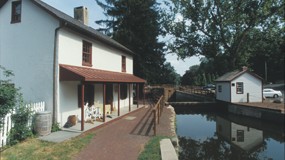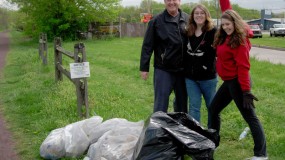From ‘Let It Flow’ to ‘No Flow’
In our last newsletter, we shared the State Park goal of having water from the Lehigh River flow south in the Canal from Easton to New Hope this summer. In spite of repair and maintenance work, the Lehigh River water did, indeed, make it all the way to Centre Bridge by late September, just three miles short of the Lock 11 goal. (In fact, the Canal looked more beautiful than it has in many a year during the Friends’ Canal Walks on September 28 and October 5.) This accomplishment did prove that the Canal can be watered in the northern end.
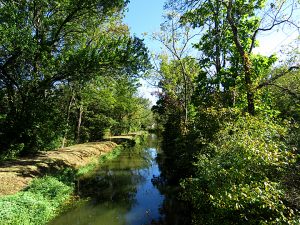
The late summer news about the Canal from New Hope south to Bristol Borough hasn’t been as good. The water levels in the Canal were fine through spring and mid-summer, but then the Delaware River dropped quickly. The river level dropped below the level of the New Hope inlet and continues to be down. Since the entire southern end of the Canal is supplied with Delaware River water through this inlet, the Canal is water starved. (This occurs when the reading at the National Oceanic and Atmospheric Administration (NOAA) gauge at Trenton is “9 feet” or below.)
Now we are faced with having the entire Canal dewatered for an extended period of time because of construction and repair projects. The Park staff began dewatering the Canal on October 7 because of restrictions related to the habits and habitat of the Eastern Red Belly Turtle, a Pennsylvania threatened species. Find out more about these turtles on page 7.
Loftus Construction has been given “notice to proceed” with the replacement of the Kleinhans (aka Fry’s Run) Aqueduct at a cost of $780,000. The aqueduct, located 6.8 miles south of Easton, failed after a local torrential downpour. Fortunately, it is the shortest aqueduct on the Delaware Canal, and many of the component parts are being pre-fabricated. The contract length is not to exceed 270 day after commencement.
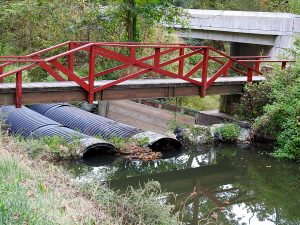
The repair of the bank blowout and the steel trough of the Tinicum Aqueduct was put out to bid and is currently pending the award process. The estimated amount for this repair is between $1 and $1.4 million with the contract length not to exceed 270 days.
Another torrential rainfall caused the berm bank north of the aqueduct to collapse, dumping the Canal’s water into Tinicum Creek. The temporary solution to maintaining water flow has been to fabricate canal banks with highway Jersey barriers and lining the channel with pool liner. This project will also address the holes in the aqueduct steel trough and the leakage through the stone walls. Unfortunately, the replacement of the steel trough with a real aqueduct structure has been postponed into the future.
The towpath in the vicinity of both the Kleinhans Aqueduct and the Tinicum Aqueduct projects will be closed to the public during the construction period.
In addition to these two major construction projects, the Park staff will take advantage of the dewatered Canal by replacing the drop gate at Locks 22/23 at the Theodore Roosevelt Recreation Area in Raubsville, undertaking a variety of repairs, and removing silt bars and trees.
The Canal from New Hope to Bristol Borough will remain in its low water state while several projects are completed. The canal prism will be relined in the vicinity of Airport Road in Bristol Township preventing canal water from infiltrating into adjoining properties. The Friends plan to repair the historic Thompson-Neely Camelback bridge this winter, and the Park will be dredging and removing trees.
With all this news comes the promise by the State Park that water will be restored as soon as it can possibly be.
And through it all, please keep the vision of the Canal at its fully watered best in your head because step by step we’re getting there.
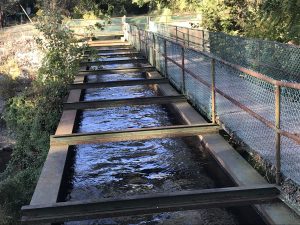
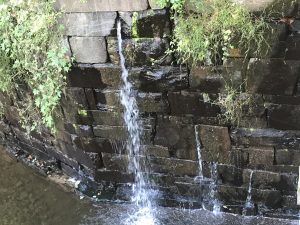
++++++++++++++++++
Welcome, Devin!
Cindy Adams Dunn, Department of Conservation and Natural Resources Secretary, announced the appointment of Devin Buzard as manager of the Delaware Canal State Park Complex on August 30. Jumping right into the partnering aspects of his new job, Devin introduced himself at the Friends of the Delaware Canal Board meeting on September 3.
Devin’s experience managing some of the Commonweath’s more heavily visited parks will serve him well as he takes on the task of dealing with not only the 58.9-mile-long canal, but also the 90-acre Giving Pond, eleven river islands, a stretch of the Nockamixon Cliffs, miles of river shoreline, and the Ralph Stover State Park.
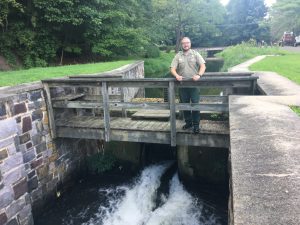
“ I’m looking forward to continuing to build, sustain, and develop strong partnerships with those who know and appreciate these two parks, as well as the many community groups that support outdoor recreation and conservation in the area,” said Devin about his appointment.
Beginning his career with DCNR’s Bureau of State Parks in 2011, Devin worked as field training coordinator with the Park Operations and Maintenance Division in Harrisburg. In 2013, he was appointed manager of Beltzville State Park in Carbon County, overseeing a 2,972-acre park developed around the Beltzville Dam, a U.S. Army Corps of Engineers flood control project.
He was named manager of the Tobyhanna State Park Complex in Monroe and Wayne counties in 2017. Three state parks – Tobyhanna, Gouldsboro, and Big Pocono – comprise that 9,550-acre complex. Most recently, Devin served as manager of the Gifford Pinchot State Park Complex , which included the Susquehannock and Sam Lewis state parks in York and Lancaster counties.
Before joining the Bureau of State Parks, Devin served in the U.S. Marine Corps as a military police officer, attaining the rank of corporal. He is a graduate of the Pennsylvania State University, where he received a bachelor’s degree in recreation, park, and tourism management. Devin and his wife are parents to two children, ages 6 and 9.
We wish Devin all the best in his new and challenging endeavor!
++++++++++
The Tale of Two Tandems
Four Canal paddling adventures are sponsored by the Friends each year in partnership with the Delaware Canal State Park educators. In addition, the educators guide many other public paddles in the Giving Pond and on the Delaware River and Canal. During each session, participants may use the Park’s twelve single and two tandem kayaks for a nominal fee. It’s a great opportunity to find out whether kayaking is a sport for you.
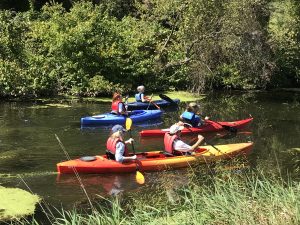
This year, the Park’s two tandems were looking particularly sad, and one was taking on water at a rate that led to its retirement. To replenish the Park’s fleet, the Friends of the Delaware Canal purchased a 14.5-foot Manatee Deluxe Tandem Kayak from L. L. Bean and donated it to the Park. This new kayak’s advantage is that it is a sit-in model that reduces the chances that its paddlers will get really wet. The new kayak has already been put to good use and christened with canal mud.
A second donation of a tandem kayak is happening this fall thanks to the generosity of Board member Judy Franlin and her husband Joe. Their downsizing means that the Park’s other sad tandem can be retired, too. Thanks, Judy and Joe!
Come next paddling season, these two tandems will be ready and waiting.
+++++++++++
At Last We Know
It was commonly known that there were only two “bump” bridges along the Delaware Canal, and they were located in Bristol Borough by the Grundy Woolen Mill. Built between 1873 and 1876, the swing bridges served as canal crossings for the newly opened Jefferson Avenue and Washington Street.
What wasn’t known was what they looked like. Aerial views and photos taken from a distance were the only available documentation. One could make out triangular structural members, but that was about it. The opportunity to solve the bump bridge mystery presented itself with the Bristol Borough interpretive sign project.
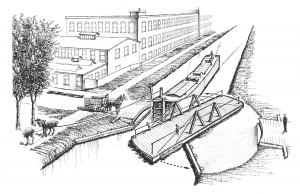
A new panel at Jefferson Avenue about the unique bridges seemed in order, but what to put on it? An inquiry to canal authorities was sent over the internet, and a reply from Ohio promptly arrived in our Inbox. Terry Woods , past president of the Canal Society of Ohio and the American Society, maintains a forum for canallers. The bump bridge question intrigued him so he did some of his own research and put out the question to others. In came a response from Dave Neuhardt, another Ohio canaller, who knew about “ a bunch of them on the Miami & Erie Canal.” He provided a description of the mechanism, an account of how it worked, and, most importantly, a line drawing of a swing/bump bridge.
The Ohio description and the image fit what was known about the Bristol Borough bump bridges, so the information was used to create the drawing and text for the new interpretive sign.
Here is the description shown on the new Bristol Borough interpretive sign:
The advantage of a bump bridge was that it swung open while being gently bumped by an oncoming canal boat. The structure was counterbalanced so that it returned to its original position after the boat had passed. No additional power was need to operate the bridge. They could be used where the land was flat, avoiding the sloping approaches of a typical bridge.
When neighborhood children saw a canal boat coming, they would jump on the bump bridge for a ride. Too many “riders” made a canal boat captain angry because his mule team had to pull harder to make the bridge open, and it was nearly impossible for the bridge to swing closed on its own.
The two bump bridges were replaced by culvert pipes after the Canal closed for business in 1931.
++++++++++
Time to Celebrate!
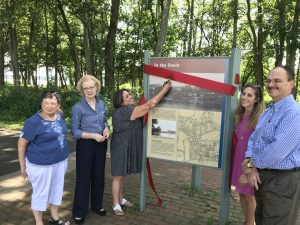
The Friends and our project partners marked the culmination of a two-year-long project to update content and replace twelve interpretive signs that tell the story of the Delaware Canal in Historic Bristol Borough. The signs dot the Canal’s route from the terminus at the Delaware River to the Lagoon at Jefferson Avenue.
The illustrated signs relate:
Where the Canal Met the River * Working with the Tide * In the Basin * Fueling the Economy * Lock 1 – The Canal’s First and Last * The Locktender’s House at Lock 1 * The Bend before the End * Lock 2 – In the Middle * Lock 3 – At the Heart of Commerce * An Industrial Zone of Its Time * Water and Land Marks * A Different Kind of Canal Bridge
We are so grateful to the Grundy Foundation, the Bucks Country Conference and Visitors Bureau, the Bristol Cultural and Historical Foundation, and Bristol Borough Council for helping to renew the Canal’s rich history.
++++++++++
The Canal’s Threatened Turtle
Eastern Red Belly Turtles were sighted in the southern end of the Canal over fifteen years ago. Soon thereafter, they were also noted in the northern end. Their existence has impacted the Canal ever since.
The Eastern Red Belly Turtle is a reptile species of special concern and has been listed as a threatened species by the Pennsylvania Fish and Boat Commission. Habitat destruction, poor water quality and competition with aggressive non-native turtle species led to the listing.
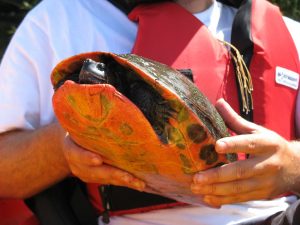
To protect the Red Belly Turtle population, special procedures must be followed when disturbance of their habitat is planned. In the case of the Delaware Canal, it is permissible to perform work in the Canal during the turtles’ active period from April to October when they are capable of moving away from construction activity. If work is undertaken during the turtles’ hibernation period between October 15 and April 15, the Canal must be de-watered no later than October 15, so that the turtles can find places to hibernate that are out of harm’s way..
The Delaware Canal State Park staff began to dewater the Canal on October 7 to comply with the Eastern Red Belly Turtle restrictions enforced by the Fish and Boat Commission. If the Canal’s water was drawn down after October 15, it is possible that cold-blooded turtles hibernating in the muddy bottom of the Canal would be exposed to freezing temperatures and die a slow and painful death. It is permissible to re-water the Canal during the hibernation period, so if projects are completed before April 15, water can be re-introduced.
The Eastern Red Belly Turtle is one of Pennsylvania’s largest native aquatic turtles. Found in the southeastern and southcentral regions of the Commonwealth, they live in slow rivers, reservoirs, ponds, marshes and ditches; and spend a lot of time basking. They are described as being shy or wary. Thus it’s understandable that they aren’t ones to show off their red bellies.
+++++++++++
Taking Care of the Outside
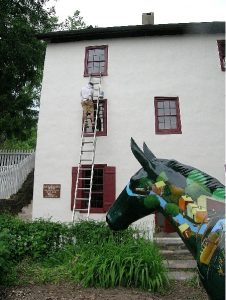
The Locktender’s House at Lock 11 in New Hope is where the Friends do business and invite visitors in to learn about “Life at the Lock” on the Delaware Canal. It’s a circa 1830, three-story plus attic, stucco over stone house that has been used in different ways over the years.
In 1991, the Friends’ cajoled the Commonwealth of Pennsylvania into buying the house by promising to restore the building and open it to the public. Its location by the then-operating New Hope Mule Barge Ride was ideal.
The Friends raised the funds to restore the building (its interior was very 1950’s), and its doors have been open ever since. Of course, every old house needs maintenance and repairs, and the Friends, as good caretakers, have undertaken many.
This year it was clear that the time had come to take care of the exterior stucco damage caused by an unprecedented canal leak and paint the exterior walls, porch roof and floor. Masterfully, tackling the job have been Jason Butler of Premiere Plaster and Construction and Mark Malone of MCM Painting.
Soon the Locktender’s House will be back to showing off its unblemished, historically appropriate façade thanks to your support of our efforts.
++++++++++
Duly Recognized
Only six camelback bridges that retain their authentic structure remain along the length of the Delaware Canal. To recognize their important places in the history of the Delaware Canal, small plaques, which display their names, significance, and mileage locations; have been affixed to the bridge abutments. Many thanks to Canal Action Team leader Josh Gradwohl for taking on the complicated fastening task!
Keep an eye out for the new signs.
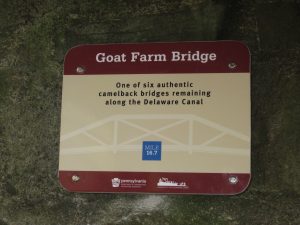
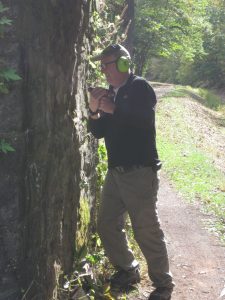
++++++++++
Help Clear the Mile Markers
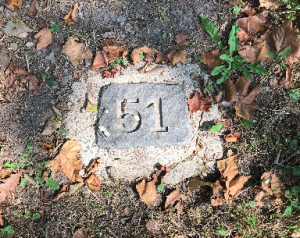
If you come upon one of the 59 granite mile markers along the Canal towpath and find it obscured by grass, weeds, or dirt, please clear it off, so that we all can count the miles. Thank you!
Mile Marker 1 is located by the Grundy Mill in Bristol Borough, and Mile Marker 58.9 is at the Forks of the Delaware in Easton.
++++++++++
Pop-Ups
Our Solution to Unpredictable Weather
Dates, Times, Places TBD
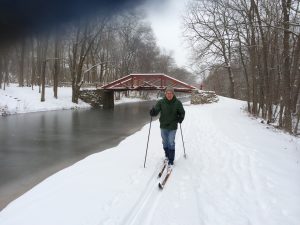
For two years in a row, bad weather conditions have foiled our efforts to have winter activities along the Canal. Too cold, too warm, too muddy, too wintery mixy. But, the lures of ice skating, snow shoeing, cross country skiing, and brisk walking are still strong, so we’re going to endeavor to have Pop-up events – again.
When the forecasters agree that the skies will be sunny, the temperatures above frostbite, and the winds relatively calm OR when we have a perfect snowfall, we will send out a message letting you know what we’ll be doing and where/ when we’ll be doing it along the Canal’s length.
We will be waiting for the right opportunities and will notify you of the details in two ways:
- Adding an Event to our website fodc.org
- Posting on the Friends of the Delaware Canal Facebook page
Be on the lookout for winter fun along the Canal.
++++++++++
Welcome, New Friends!
Rachel Albright
Hillary Armitage
Mary Arndtsen
Laura Baird
Wayne Baldwin
Francis Collins
Daphne Daniel
Meg Del Prete
Donna Doan
Elissa Garofalo
Doreen Gramling
Susanne Greczylo
Karen and Michael Hrabowski
Kim and Tyler Jones
Lesley Larson
Cindy and Sean Legg
Marilyn Marquis
Tom Merchant
Matt Murray
Joshua Nay
John Nolan
Kris Reilly
Anne Sears
Kenneth Standig
Jacqueline Strigl
Cindy Wallace
Betsy Werley
Marilyn White
